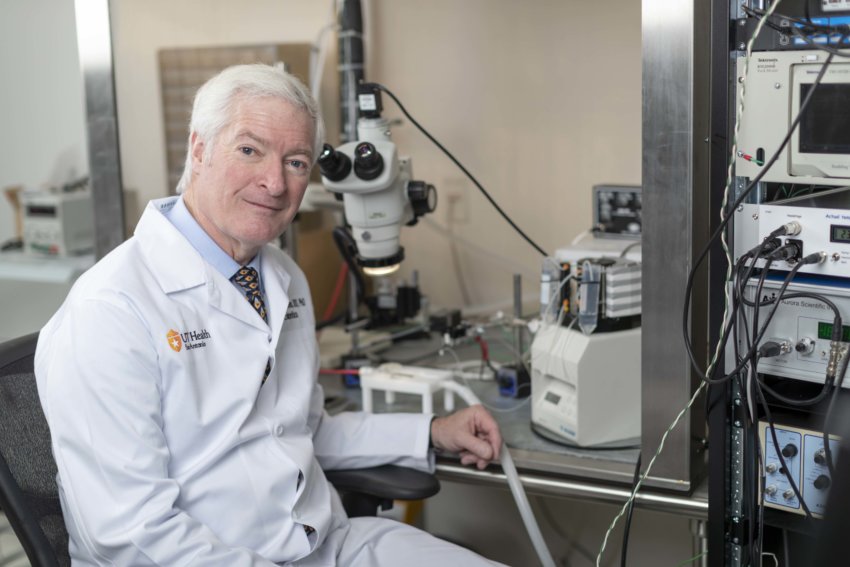(SAN ANTONIO (April 29, 2019) ― UT Health San Antonio has received a $6 million grant from the Department of Defense to continue work on a new, nonaddictive class of pain relievers.
Kenneth Hargreaves, D.D.S., Ph.D., is principal investigator of the four-year grant. It will fund the last phase of preclinical work to identify the best drug formulations and move them into animal trials in collaboration with the U.S. Army’s Institute for Surgical Research at Fort Sam Houston.
“There are many initiatives underway to slow down and stop the opioid epidemic. Some of them relate to treatment for patients who have become dependent on opioids, some relate to better treatment of pain that leads to opioid use and some relate to bringing naloxone into the community to reverse overdoses,” said Dr. Hargreaves, professor and chairman of the Department of Endodontics in the School of Dentistry. He also is a member of the Internal Advisory Committee of UT Health San Antonio’s Military Health Institute.
Caring for our military members and veterans
“The approach that we are taking is to develop novel nonaddictive, nonopioid analgesics that will be of particular benefit to injured service members,” he said.
Military members and veterans suffer significant pain with injuries from improvised explosive devices, burns and trauma. “IEDs are involved in 5% to 10% of combat injuries. Those who are injured require lengthy care and resources from the battlefield through rehabilitation,” Dr. Hargreaves explained.
In addition, each year more than 2 million U.S. civilians experience significant burn injuries. Although opioids are the standard treatment for burn pain, their effectiveness is limited. Opioids can cause major side effects, such as tolerance that results in the need for higher doses for the same effect, dependence on the drugs and death from substance use disorder.
Disrupting the cycle
For more than a decade, Dr. Hargreaves and his team have studied the processes involved with burn pain. “We wanted to learn how skin cells talk to pain neurons,” he said. Transient receptor potential vanilloid 1 (TRPV1) has long been recognized as a key pain receptor.
The team discovered that an essential omega-6 polyunsaturated fatty acid, linoleic acid (LA), plays a major role. “By essential, we mean that this fatty acid is required by the body, but the body doesn’t make it. It must be ingested by eating foods with omega-6 or taking supplements. Once in the body, this fatty acid is stored in cell membranes,” he said.
When the body experiences pain, LA is released from the cell membranes near the burn. It makes enzymes that start a process called oxidation that sends pain signals through the TRPV1 pathway to the brain. These enzymes, called oxidized linoleic acid metabolites (OLAMS) are the key to communicating the pain signal, the researchers discovered.
“Telling the brain that your hand is on a hot stove is a good thing, so that you can remove it quickly, but we have learned through our studies that the body keeps sending the pain signal over and over for months―sometimes up to a year and even after the injury has healed―causing chronic pain. This is the kind of pain we hope to reduce,” Dr. Hargreaves said.
The OLAMS are similar to capsaicin, the substance in chili peppers that gives them their heat, so the TRPV1 receptor is often called the capsaicin receptor. Its synthetic chemical cousin capsazepine is a compound that blocks the pain receptor. It is one of the substances Dr. Hargreaves has been evaluating for pain relief.
Pain studies in humans
“After our next phase of studies, we will have a much better understanding of how well these drugs work and their safety. Those are two necessary pieces of information that we need to go to the FDA (Food and Drug Administration) to test them in humans,” he said.
“We are grateful that we have collaborators at the ISR that will help us on this project and we’re grateful to the Department of Defense for their continued support,” he said.
Previous preclinical and animal research has been funded by a $1.4 million DOD grant.
# # #
For current news from the UT Health Science Center San Antonio, now called UT Health San Antonio™, please visit our online newsroom, like us on Facebook or follow us on Twitter.
# # #
The University of Texas Health Science Center at San Antonio, now called UT Health San Antonio®, is one of the country’s leading health sciences universities. With missions of teaching, research, healing and community engagement, its schools of medicine, nursing, dentistry, health professions and graduate biomedical sciences have produced 36,500 alumni who are leading change, advancing their fields and renewing hope for patients and their families throughout South Texas and the world. To learn about the many ways “We make lives better®,” visit www.uthscsa.edu.


